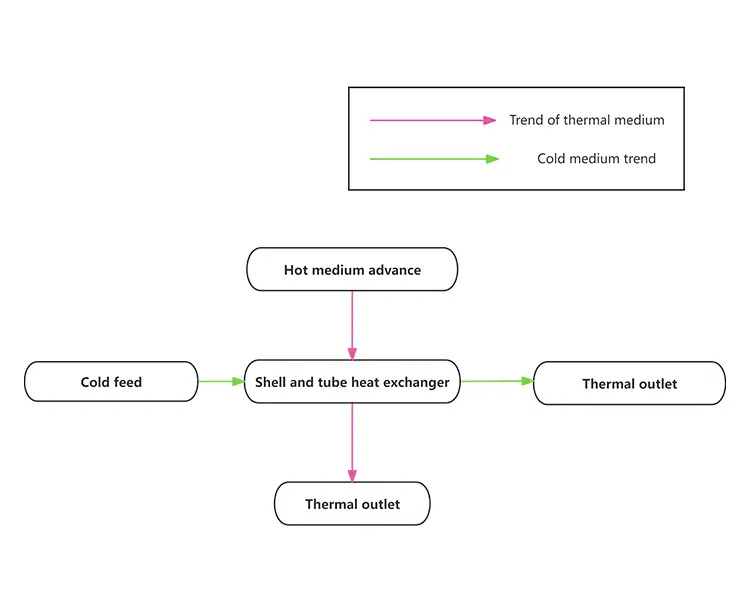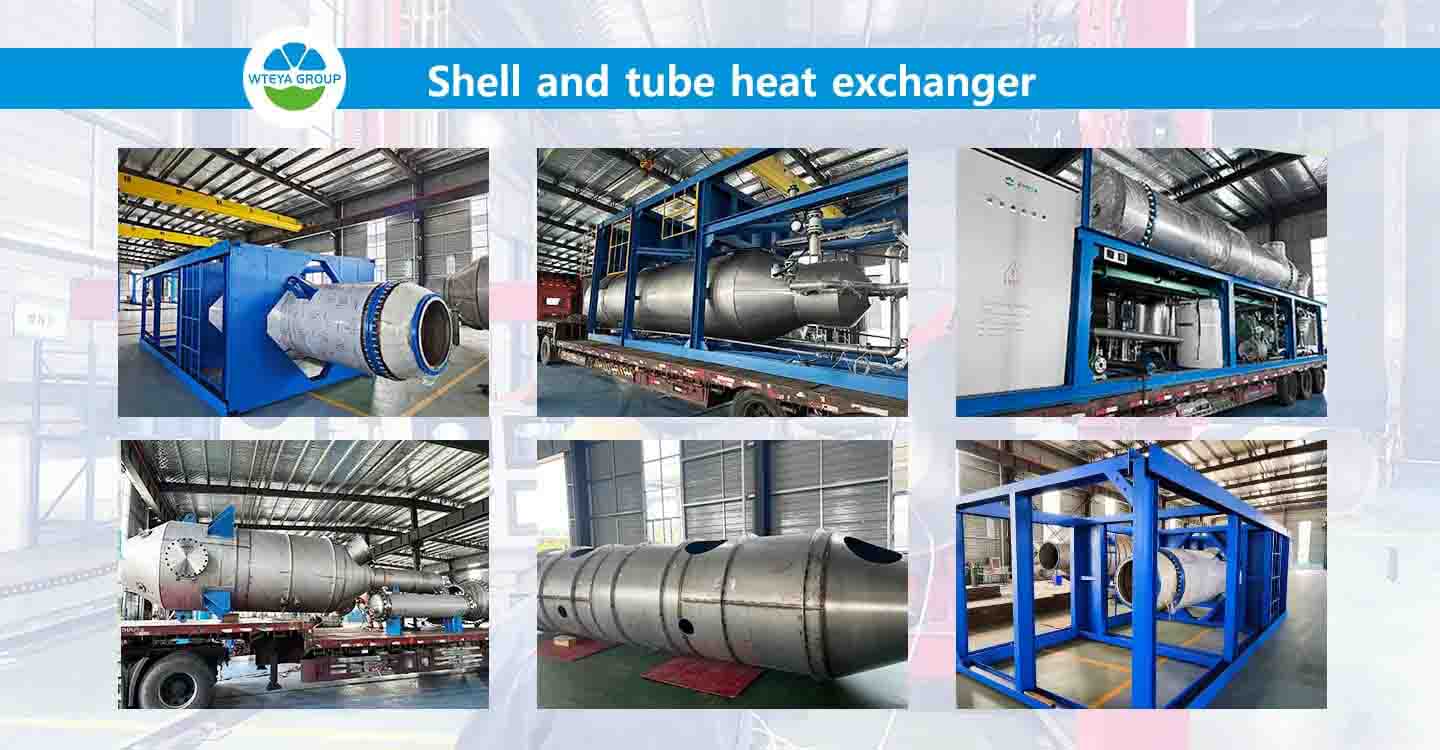Tubular Heat Exchanger: Efficient Thermal Solutions
Menu
Latest News
Product introduction
Introduction to tubular heat exchanger
A tubular heat exchanger, also known as a tubular heat exchanger, is a device that uses a tube bundle enclosed in a cylindrical shell for heat exchange. Tubular heat exchanger is a kind of equipment widely used in industrial processes for heat exchange, it is suitable for high temperature, high pressure working environment, can handle the heat exchange needs of various fluids.
Tubular heat exchanger composition
Tubular heat exchanger is mainly composed of shell, heat transfer tube bundle, tube plate, baffle plate (baffle) and tube box and other components.
1. Shell: usually cylindrical, it is the external structure of the heat exchanger, and the heat transfer tube bundle is contained inside.
Heat transfer tube bundle: located inside the shell, both ends are fixed on the tube plate, is the main place to achieve heat exchange.
2. Tube plate: located at both ends of the shell, it is used to fix the heat transfer tube bundle and form a seal with it to ensure that the two fluids will not mix.
3. Baffle (baffle) : installed in the shell, used to guide the shell flow through the tube bundle several times, increase the degree of fluid turbulence, improve the heat transfer efficiency.
4. Pipe box: located at both ends of the heat exchanger and connected with the tube plate, it is used to distribute and collect pipe flow.
Tubular heat exchanger features
The advantages of tubular heat exchangers mainly include:
1. High heat transfer coefficient: The threaded tube used in tubular heat exchangers is made of materials with high thermal conductivity, such as copper or stainless steel, and the design of the combination of internal and external threads can form strong turbulence under little fluid resistance, thus greatly improving the heat transfer coefficient inside and outside the tube.
2. Compact structure: Because the unit volume heat transfer area of the tube heat exchanger is large, the total heat transfer coefficient is high, so the floor area is small, saving materials and space.
3. Not easy to scale: The special concave and convex structure of the threaded pipe and the hot extension and cold shrinkage of the pipe make it difficult to retain impurities inside and outside the pipe, so it is not easy to scale, to ensure the long-term operation effect.
4. Not easy to leak: the sealing circumference of the tube heat exchanger, and the coarse thread of the threaded pipe has a compensation capacity similar to the expansion joint, making the thermal stress of the heat exchanger small and not easy to leak.
5. Strong applicability: According to different process requirements, there are many types of tubular heat exchangers, such as fixed tube plate, floating head type, U-shaped tube type, etc., each has its own characteristics and scope of application, which can meet the needs of different working conditions.
6. Easy maintenance: Some types of tube heat exchangers are designed to allow tube bundles to be drawn from the housing for easy cleaning and maintenance, especially for media that are prone to scaling or require frequent cleaning.
Tubular heat exchanger applications
Chemical industry: In the chemical reaction process, it is often necessary to heat or cool raw materials or products, and tube heat exchangers play an important role here.
Oil and gas industry: These industries often need to exchange heat for oil and gas during the refining process, and tube heat exchangers can withstand the high temperatures and pressures of these processes.
Food industry: In the process of food processing, tubular heat exchangers are used for heating, cooling and pasteurization to ensure the safety and quality of food.
Power industry: In power plants, tube heat exchangers are used for the generation and condensation of steam and are key equipment for the normal operation of power stations.
Metallurgical industry: In the process of metal processing, tube heat exchangers are used for temperature control of heat treatment furnaces, as well as for cooling metal products.
Hvac industry: In heating and air conditioning systems, tubular heat exchangers are used for heating and cooling hot water to keep the indoor temperature comfortable.
Technical principle of
The technical principle of shell and tube heat exchanger is mainly based on wall heat transfer, in which a fluid flows inside the tube bundle, and another fluid flows in the shell outside the tube bundle, and the two exchange heat through the tube wall. Specifically, the working principle of shell and tube heat exchanger includes the following aspects:
1. Heat transfer surface: the wall of the tube bundle is used as a heat transfer surface, and two kinds of working fluids flow inside and outside the tube respectively, and heat exchange through the tube wall.
2. Fluid flow: pipe flow in the tube, shell flow outside the tube. In order to improve the heat transfer efficiency of the pipeline fluid, some designs use spiral tubes or nodule tubes, which can increase the degree of turbulence of the fluid, thereby improving the heat transfer coefficient.
3. Temperature control: By adjusting the heat source flow into the heat exchanger, the temperature of the heated medium can be controlled. For example, there is a regulating valve before the heat source inlet, and changing the valve opening can adjust the outlet temperature.
The production process of

The design and manufacture of shell-and-tube heat exchangers is a complex process that requires comprehensive consideration of many factors, including process requirements, material selection, structural design, safety standards, etc.
1. Check the heat transfer coefficient and heat transfer area: Calculate the heat transfer coefficient K and heat transfer area F according to the heat transfer coefficient of pipe and shell, dirt thermal resistance, wall thermal resistance, etc. This step takes into account a number of factors, such as differences between operating conditions and design conditions, and possible future scaling or clogging problems.
2. Manufacturing technology: The manufacturing process of shell and tube heat exchanger includes selecting the appropriate material, determining the specifications and arrangement of the tube bundle, and the number of baffle or support plate. These manufacturing details are critical to the performance and durability of heat exchangers.
3. Design conditions: Users need to provide some key design conditions, such as operating pressure, operating temperature, metal wall temperature, material name and characteristics, corrosion margin, number of passes, heat exchange area, heat exchange tube specifications, etc. This information is essential for the design of an efficient and safe heat exchanger.
Production of equipment

Wteya aims to digital and intelligent production to provide superior products and services to its customers. We not only provide a wide range of standard products which are seriously tested and stable performance to meet a wide range of industrial needs. We also provide custom service, as well as OEM and ODM services, professional design team provides proper solutions for customers to meet their unique needs. We will work closely with each customer to ensure that every device suits customer's process requirements and production process accurately. Wteya's one-stop service, innovative to create high-quality mechanical products and system solutions, professionally help customer deal with various water treatment problems.
Capacity and size
|
Basic parameter table (outer diameter of heat exchange tube Ø20) |
||||||||
|
Nominal diameter |
Number of heat exchange tubes |
Center arrangement tube |
Pipe flow area |
Calculate the heat transfer area |
||||
|
1500 |
2000 |
3000 |
4500 |
6000 |
||||
|
159 |
15 |
5 |
0.003 |
1.4 |
1.9 |
2.8 |
|
|
|
219 |
33 |
7 |
0.0066 |
3.1 |
4.1 |
6.2 |
|
|
|
273 |
65 |
9 |
0.013 |
6.1 |
8.2 |
12.3 |
18.4 |
24.5 |
|
325 |
99 |
11 |
0.0199 |
9.3 |
12.4 |
18.7 |
28 |
37.3 |
|
400 |
174 |
14 |
0.035 |
16.4 |
21.9 |
32.8 |
49.2 |
65.6 |
|
500 |
275 |
19 |
0.0553 |
|
34.6 |
51.8 |
77.8 |
103.7 |
|
600 |
433 |
21 |
0.136 |
|
54.4 |
81.6 |
122.5 |
163.2 |
|
700 |
595 |
25 |
0.187 |
|
74.7 |
112.1 |
168.2 |
224.3 |
|
800 |
769 |
29 |
0.242 |
|
96.6 |
144.9 |
217.4 |
290 |
Frequently Asked Questions
Large fluctuation of outlet pressure: this may be caused by leakage at the connection between the tube and the tube plate. The sealing of the joint needs to be checked regularly, and the necessary maintenance and replacement are carried out.
Scaling problem: Scaling will affect the heat transfer efficiency, regular cleaning of the heat exchanger, the use of appropriate cleaning agents and methods to remove the inner wall of the scale, you can maintain the heat transfer efficiency.
Corrosion problems: Corrosion can compromise the life and safety of heat exchangers. Choosing corrosion-resistant materials to make heat exchangers, or adding inhibitors to corrosive media, can reduce the occurrence of corrosion.
Leakage problem: Leakage may be caused by poor sealing or damage to the bundle. Regular inspection of seal and tube bundle condition, timely replacement of damaged parts, can prevent leakage problems.







